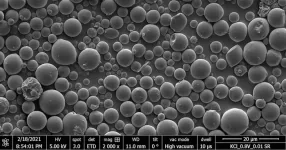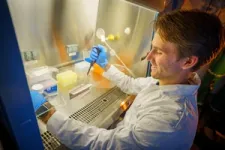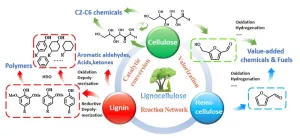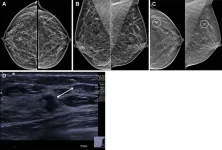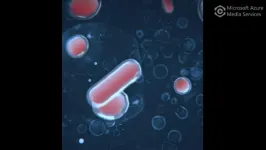(Press-News.org) A team led by engineers at the University of California San Diego has developed a biodegradable polymer system to treat rheumatoid arthritis, an autoimmune and inflammatory disease, by working in concert with the power of the human immune system.
The research builds on increasing clinical interest in modulating the immune system to treat cancers and autoimmune disease, as well as previous work with all-trans retinoic acid (ATRA) which is produced naturally in the body and helps cells grow and develop. By approaching these challenges from the perspective of a biomaterials engineering lab, the team adds two key innovations to previous methods: local release and harnessing the joint microenvironment for sustained effectiveness.
With this method, encapsulated ATRA is injected directly into a joint affected by rheumatoid arthritis, where it remains in effect for at least several weeks. During that time, ATRA transforms disease-causing cells into disease-stopping cells, known as regulatory T cells, which can treat or prevent the disease elsewhere in the body.
“Essentially, our system turns the disease site into a factory that produces regulatory T cells,” said David A. McBride, a chemical engineering graduate student at UC San Diego supervised by nanoengineering professor Nisarg Shah. “It uses a biodegradable biomaterial to facilitate the timed release of ATRA, which reprograms T cells so they can treat disease.”
The research was published in the March 8, 2023 issue of Advanced Science. McBride is a coauthor on the paper.
"This is a very promising line of research utilizing the latest and greatest technology in immunoengineering to combat arthritis,” said Iannis Adamopoulous, an associate professor of medicine at Harvard’s Beth Israel Deaconess Medical Center, Department of Medicine, Division of Rheumatology.
What is ATRA?
ATRA is a small molecule currently FDA approved to treat acute promyelocytic leukemia (APML). Research over the last two decades has suggested that it also has promise in treating autoimmune arthritis and relieving inflammation. However, that method relies on ATRA traveling freely throughout the body, which can cause immunosuppression and potentially significant off-target toxicity, along with other unwanted side effects.
“Previous work established that ATRA has potential in treating autoimmune arthritis, but the route of administration precluded the work from being relevant to clinical translation,” said McBride.
When ATRA is encapsulated using biodegradable materials, it can be injected directly into joints at therapeutic concentrations but as it diffuses out of the joint, it enters circulation at much lower concentrations, minimizing or preventing unwanted effects. Without the controlled release afforded by the biomaterial encapsulation, patients would require multiple injections per day to achieve the same effects, which would be impractical in most cases.
How it works
When the human immune system functions properly, helper T cells patrol the body in search of disease-causing pathogens. When a pathogen is detected, a helper T cell can recruit additional cells to help fight it. “It’s kind of similar to how you might have police cars roaming the city, and when one sees a crime occurring, they call for backup to get the situation under control,” said McBride.
Many autoimmune diseases result from cases of “mistaken identity,” in which these cells attack a perceived danger target that is in fact a part of normally functioning cells in the body. The subsequent proliferation of such pathogenic T cells, which McBride calls “bad apples,” can result from a combination of genetic and environmental factors and wreak havoc on the body when they summon large teams of immune cells for unnecessary standoffs.
For example, “in type 1 diabetes, you have bad apples that call in reinforcements against your pancreas,” said McBride. ”In multiple sclerosis, it is against your neurons. In rheumatoid arthritis, it is against your joints. So, your immune system recognizes this as something to be attacked, and it goes and recruits a bunch of additional immune cells to these places and fights a war until all the pathogens are gone. Except that, in this case, it’s not attacking pathogens, but healthy parts of the body."
Many current approaches block the chemical signals that immune cells use to communicate, effectively preventing the pathogenic T cells from calling in reinforcements without eliminating the “bad apples.” Time-released ATRA reprograms them to act as regulatory T cells, or “good apples.” These cells still have the ability to recognize and activate in the joints, but rather than calling in additional immune cells, they help to resolve the inflammation. In areas such as joints, which aren’t recommended for repeated injections, the sustained-release formulation allows sufficient therapeutic exposure to flip the balance.
ATRA makes lasting modifications to the ability of cellular machinery to read cell DNA, improving the function of the anti-inflammatory regulatory T cells. This treats T cells at the site of disease and generates regulatory T cells specific to that diseased tissue. Then, when these cells move to other disease locations, they can help resolve inflammation and promote healing. Because the cells are specific to the disease, they don't interfere with normal immune function, allowing them to supplement existing therapies or provide alternatives for patients who need them.
“The coolest part about this is that the treated site of disease, where the bad apples were previously proliferating, now becomes a place that can generate regulators that can now go patrol the body and actually prevent disease,” said McBride.
The limitations of existing approaches
Patients with rheumatoid arthritis are frequently treated with disease-modifying anti-rheumatic drugs (DMARDs) and in many patients this approach works well. However, about a third of patients don’t adequately respond to front-line DMARDs, and they come with some significant disadvantages.
First, while using DMARDs, some patients become more susceptible to infectious disease and exhibit weaker responses to vaccines. In this regard, “the COVID-19 pandemic has brought a lot more understanding on the risks of immunosuppression into public awareness,” said McBride.
Additionally, because most immunosuppressives currently used to treat rheumatoid arthritis stay in the system for up to two weeks, there is no option to discontinue treatment if a dangerous infection occurs. This is compounded when patients use two or more treatments simultaneously, which is not uncommon due to the complexity of the disease. Using multiple powerful immunosuppressants can exacerbate the risks of infections or cancer.
“If you can instead have a treatment option that doesn’t have an immunosuppressive effect, you can really reduce the risk for patients that need multiple treatment modalities to keep their autoimmune disease in check,” McBride said.
Finally, for some patients, immunosuppressives work well for a time and then lose their effectiveness. This can happen when their bodies develop antibodies that neutralize the medications or new disease pathways emerge. New treatments like this one could potentially supplement DMARDs, compensating for waning effectiveness or requiring lower doses to start with.
"In well controlled patients, reducing or eliminating the need for immunosuppressive drugs is desirable,” said Shah. “However, when it is attempted, studies have shown that the disease can flare up again. So having a non-immunosuppressive option could go a long way.”
Research methods, challenges and next steps
The team tested its biomaterial-encapsulation method using a combination of mouse and human cells. After this achieved positive results, they transitioned to mouse models of autoimmune arthritis, coming closer to simulating the remarkable complexity of a real-life case of autoimmune disease in a human subject.
The work required multiple models of disease, each designed to demonstrate a specific aspect of the team’s hypothesis, as well as rigorously tracking the cells from their origin points at injection to the other locations where they recirculated and proved effective in fighting disease.
Currently, the researchers are actively working toward commercialization. “As this is my first experience with something like this, it is difficult for me to estimate, but we are currently targeting approval to start clinical trials within five years,” said McBride. To evaluate possible commercialization routes, McBride has participated in the UC San Diego Institute for the Global Entrepreneur (IGE) NSF I-Corps and MedTech Accelerator programs.
The power of a multidisciplinary approach
When he entered graduate school at UC San Diego, McBride was focused on modeling complex signaling patterns in biological systems, for which rheumatoid arthritis provided many intriguing examples. He became more engaged as he gained awareness of the human side of the disease.
“I’m always surprised at how many people know someone fighting an autoimmune disease or are struggling with one themselves,” he said. “These experiences have really moved it from an interesting problem on paper that I’m trying to solve to a real, difficult problem in the lives of friends and family,”
This research required a highly interdisciplinary approach, relying on input from experts in biomaterials design, immunology, clinical rheumatology and beyond. McBride credits the highly collaborative environment on the UC San Diego campus as a crucial factor in its success.
“UC San Diego doesn’t only promote academic collaboration, but also provides several resources for translating our discoveries beyond the lab and into the clinic,” he said. “Most recently, we are excited to have been awarded a UC San Diego internal grant under the Accelerating Innovations to Market program.”
Shah, McBride and paper co-senior author Nunzio Bottini, MD, PhD, a former Professor of Medicine at UC San Diego, now with Cedars-Sinai Medical Center, received the Accelerating Innovation to Market (AIM) award for 2023. “By including high-caliber industry and investment experts in the selection process, it provides precious validation of the commercial potential of our idea,” Bottini said. “Plus, it supports the laboratory in completing proof of concept validation work needed to accelerate translation.”
Paper: Immunomodulatory microparticles epigenetically modulate T cells and systemically ameliorate autoimmune arthritis
Coauthors: David A. McBride and Matthew D. Kerr, Department of Nanoengineering and Chemical Engineering Program, UC San Diego; Wade T. Johnson, Department of nanoengineering, UC San Diego; Anders Nguyen, Department of Rheumatology and Inflammation Research, Sahlgrenska Academy, Institute of Medicine, University of Gothenburg, Sweden; Martina Zoccheddu, Department of Medicine, Division of Rheumatology, Allergy and Immunology, UC San Diego; Mina Yao and Edward B. Prideaux, Department of Chemistry and Biochemistry, UC San Diego; Nicholas C. Dorn, Department of Nanoengineering and Chemical Engineering Program, UC San Diego; Wei Wang, Department of Chemistry and Biochemistry and Department of Cellular and Molecular Medicine, UC San Diego; Mattias N.D. Svensson, Department of Rheumatology and Inflammation Research, Sahlgrenska Academy, Institute of
Medicine, University of Gothenburg, Sweden; Nunzio Bottini*, Department of Medicine, Division of Rheumatology, Allergy and Immunology, UC San Diego; and Nisarg J. Shah*, Department of Nanoengineering and Chemical Engineering Program, UC San Diego.
*These are corresponding authors.
Sources of funding for the research include:
National Institutes of Health grant F31AR079921 (DAM)
National Institutes of Health grant F31HL164055 (MDK)
National Institutes of Health grant T32AR064194
National Institutes of Health grant T32CA153915
National Institutes of Health grant P30AR073761 (NB)
National Institutes of Health grant R03DE031009 (NJS)
National Institutes of Health grant S10OD025052
National Institutes of Health grant P30CA23100
National Institutes of Health grant UL1TR001442
National Science Foundation grant ECCS-2025752
National Psoriasis Foundation (NJS)
Arthritis National Research Foundation (NJS)
Hellman Fellowship (NJS)
Swedish Society for Medical Research (SSMF) grant S19-0062 (MNDS)
Foundation for Research in Rheumatology (MNDS)
IngaBritt och Arne Lundbergs Forskningsstiftelse (MNDS) END
Biodegradable polymer system offers new hope for treating rheumatoid arthritis
Sustained-release method works in harmony with the immune system
2023-04-04
ELSE PRESS RELEASES FROM THIS DATE:
National Comprehensive Cancer Network names the University of Chicago Medicine Comprehensive Cancer Center as 33rd Member Institution
2023-04-04
PLYMOUTH MEETING, PA and CHICAGO, IL [April 4, 2023] — The National Comprehensive Cancer Network® (NCCN®) today announced the addition of the University of Chicago Medicine Comprehensive Cancer Center as the newest Member Institution to join the not-for-profit alliance of leading cancer centers. There are now 33 academic centers across the United States contributing multidisciplinary subject matter experts to 61 different panels determining the latest evidence-based expert consensus recommendations for risk assessment, prevention, evaluation and treatment, surveillance, supportive care, and survivorship throughout the ...
A panoramic view on catalytic conversion network for lignocellulosic biomass valorization
2023-04-04
Fossil fuel consumption contributes to significant greenhouse gas emissions and severe climate issues. It is imperative to explore sustainable alternatives to the current industrial production of chemicals and fuels. The efficient utilization of lignocellulosic biomass as a substitute for fossil resources is a promising approach to promote the sustainable development of modern society. Although numerous valorization routes for lignocellulose have been explored, large-scale lignocellulose valorizations are still limited. In this regard, a group of researchers ...
Mosquito saliva can weaken body’s defenses against deadly dengue viruses, scientists discover
2023-04-04
The saliva of mosquitoes infected with dengue viruses contains a substance that thwarts the human immune system and makes it easier for people to become infected with these potentially deadly viruses, new research reveals.
Dengue has spread in recent years to Europe and the Southern United States in addition to longstanding hotspots in tropical and subtropical areas such as Southeast Asia, Africa and Latin America. The new discovery, from a University of Virginia School of Medicine scientist and his collaborators, helps explain why the disease is so easily transmitted and could eventually lead to ...
Elephants as a new model for understanding human evolution
2023-04-04
Humans have complex social behavior, diverse communication skills, and a capacity for highly developed tool use. Researchers argue that human evolution may resemble the process of animal domestication, where less aggressive animals are favoured. In the same way, human evolution may be the result of natural selection for more prosocial and cooperative individuals. Such individuals are more likely to interact with others and form complex communities, in which they can learn from each other.
“The theory of self-domestication is hard to test”, says first author Limor Raviv. “This is because only one other species besides humans has been argued ...
Deductible, co-pay may lead women to skip breast follow-up
2023-04-04
OAK BROOK, Ill. – Researchers who surveyed women attending breast cancer screening appointments found that one in five is likely to skip additional testing after an abnormal finding on their mammogram if there is a deductible or co-payment, according to an editorial published in Radiology, a journal of the Radiological Society of North America (RSNA).
Health care costs and insurance premiums have increased in recent years. With the advent of the Affordable Care Act (ACA), high-deductible health plans (HDHPs) have grown ...
Ultrasound Effective at Diagnosing Localized Breast Lumps, Pain
2023-04-04
OAK BROOK, Ill. – Ultrasound is an effective standalone diagnostic method in patients with focal breast complaints, according to a study published in Radiology, a journal of the Radiological Society of North America (RSNA). Focal breast complaints can refer to pain, lumps, nipple discharge or other symptoms and conditions confined to a specific area of the breast.
In women, focal breast complaints are a frequent problem. In the Netherlands, approximately 70,000 women visit radiology departments annually with focal breast complaints. The most common being the presence of lumps or pain. Many women who have focal breast complaints are between the ages of 30 and 50 years.
Digital breast ...
ChatGPT helpful for breast cancer screening advice with certain caveats, new study finds
2023-04-04
BALTIMORE, April, 4, 2023-- As more consumers turn to the newly available ChatGPT for health advice, researchers are eager to see whether the information provided by the artificial intelligence chatbot is reliable and accurate. A new study conducted by researchers at the University of Maryland School of Medicine (UMSOM) indicates that the answers generated provide correct information the vast majority of the time; sometimes, though, the information is inaccurate or even fictitious.
Findings were published today in the journal Radiology.
In February 2023, UMSOM researchers created a set of 25 questions related to advice on getting screened ...
Peering into ocular waste recycling
2023-04-04
A recent study in the Journal of Biological Chemistry revealed the key to a protein that commonly causes blindness. The biological process involves a protein that is essential for transporting toxic compounds out of the eye, similar to a garbage recycling service. The challenge is that, like food and the waste it generates, these compounds are essential for the eye to function properly — until they build up and cause blindness.
The scientists behind the study research a protein transporter, called ABCA4, that lines the edges of specialized photoreceptor cells in the retina and is normally poised to remove toxic, fatty retinal byproducts ...
Tired of being alone: How social isolation impacts on our energy
2023-04-04
In a study conducted in the lab as well as during the COVID-19 lockdowns, participants reported higher levels of tiredness after eight hours of social isolation. The results suggest that low energy may be a basic human response to a lack of social contact. The study conducted at the University of Vienna and published in Psychological Science also showed that this response was affected by social personality traits of the participants.
If we do not eat for an extended period, a series of biological processes ensue that create a craving sensation we recognize as hunger. As a social species, we also need other people to survive. Evidence shows that a lack of social contact induces ...
Insilico Medicine presents four posters featuring AI-designed anti-cancer drugs at AACR
2023-04-04
Insilico Medicine (“Insilico”), a clinical-stage generative artificial intelligence (AI)-driven drug discovery company, today announced that four abstracts have been accepted as poster presentations at the American Association for Cancer Research (AACR) Annual Meeting 2023.
Insilico will present four novel inhibitors for the treatment of cancer developed with its end-to-end Pharma.AI platform. Drawing from trillions of data points and millions of compounds and molecular fragments, the platform uses ...
LAST 30 PRESS RELEASES:
Air pollution exposure and birth weight
Obstructive sleep apnea risk and mental health conditions among older adults
How talking slows eye movements behind the wheel
The Ceramic Society of Japan’s Oxoate Ceramics Research Association launches new international book project
Heart-brain connection: international study reveals the role of the vagus nerve in keeping the heart young
Researchers identify Rb1 as a predictive biomarker for a new therapeutic strategy in some breast cancers
Survey reveals ethical gaps slowing AI adoption in pediatric surgery
Stimulant ADHD medications work differently than thought
AI overestimates how smart people are, according to HSE economists
HSE researchers create genome-wide map of quadruplexes
Scientists boost cell "powerhouses" to burn more calories
Automatic label checking: The missing step in making reliable medical AI
Low daily alcohol intake linked to 50% heightened mouth cancer risk in India
American Meteorological Society announces Rick Spinrad as 2026 President-Elect
Biomass-based carbon capture spotlighted in newly released global climate webinar recording
Illuminating invisible nano pollutants: advanced bioimaging tracks the full journey of emerging nanoscale contaminants in living systems
How does age affect recovery from spinal cord injury?
Novel AI tool offers prognosis for patients with head and neck cancer
Fathers’ microplastic exposure tied to their children’s metabolic problems
Research validates laboratory model for studying high-grade serous ovarian cancer
SIR 2026 delivers transformative breakthroughs in minimally invasive medicine to improve patient care
Stem Cell Reports most downloaded papers of 2025 highlight the breadth and impact of stem cell research
Oxford-led study estimates NHS spends around 3% of its primary and secondary care budget on the health impacts of heat and cold in England
A researcher’s long quest leads to a smart composite breakthrough
Urban wild bees act as “microbial sensors” of city health.
New study finds where you live affects recovery after a hip fracture
Forecasting the impact of fully automated vehicle adoption on US road traffic injuries
Alcohol-related hospitalizations from 2016 to 2022
Semaglutide and hospitalizations in patients with obesity and established cardiovascular disease
Researchers ‘listen in’ to embryo-mother interactions during implantation using a culture system replicating the womb lining
[Press-News.org] Biodegradable polymer system offers new hope for treating rheumatoid arthritisSustained-release method works in harmony with the immune system
